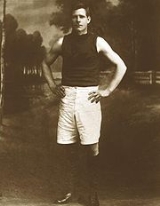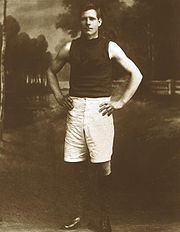
Phillip Matson
Encyclopedia
Philip Henry Matson was a highly successful player and coach of Australian rules football
in the early 20th century, chiefly in Western Australia.
in 1911, Subiaco in 1912–17 and East Perth in 1918–23. A fast, vigorous and versatile utility with an ability to take the big mark (despite being only 179 cm) he played at half-back, half-forward or took a turn in the ruck. He played for both South Australia (1909–10) and Western Australia (1908, 1911, 1914) and captained the Sandgropers at the 1914 interstate carnival
.
Away from football, Matson's working was varied and somewhat inconsistent. He had stints as a miner, a tramway motorman, a farmer, a navvy on the trans-Australian railway , a lumper, a storeman and a 'Spot-Lager' retailer. Early in his career, he was a teetotaller but eventually became a 'social' drinker and was well known for his gambling habit. His unconventional approach to life caused problems within his family, who were sometimes compelled to live in a tent. Matson offered to enlist during World War I, however when rejected he opted to live as a licensed Swan River fisherman and involve himself more heavily in gambling. He operated two-up schools at Subiaco and Pelican Point, SP books in some city hotels, and later an illegal gaming house in Perth. For a number of years, he held a trotting bookmaker's licence.
in 1918. Matson worked on the players' confidence and garnered their respect with a methodical approach to his coaching. He was lauded for his ability to outwit opponents and exploit weaknesses. Matson's dominant personality helped recruit some excellent players and a dynasty was rapidly built. In nine seasons between 1919 and 1927, East Perth won seven premierships to dominate West Australian football. In total, he played in twelve premiership teams and, in the last ten years of his career, coached teams into nine finals. He was an essential part of the state team, as a selector for the successful 1921 Western Australian interstate carnival team, and as the coach of the 1924 and 1927 teams that lost narrowly to Victoria. Controversially, he openly criticised Victorian officials in 1924 for encouraging violence against his team. This outburst came back to haunt him.
In 1925, Matson accepted an offer to coach Castlemaine, in the Victorian goldfields. Impressed with his effort in lifting the team into the Grand Final, Richmond officials approached Matson with an offer to succeed Dan Minogue as the Tigers' coach for 1926. Matson accepted and relocated to Melbourne. However, the VFL refused Matson a permit to take up the job, which incensed both club and prospective coach. It was variously suggested that the VFL officials hadn't forgotten Matson's outburst two years earlier or that they disapproved of his unconventional lifestyle. Whatever the reason, Matson quickly headed back to Perth in time for the football season and was re-appointed to coach East Perth. He took them to successive premierships. Matson's had revenge on the VFL officials by inspiring Western Australia to two 'spiteful, vicious, brutal' victories over Victoria in 1926.
Inducted into the AFL's Hall of Fame in 2004, Matson's citation reads:
Phil Matson, who is revered in Western Australia as one of that state’s greatest ever coaches in much the same way Collingwood’s Jock McHale is revered in Victoria.

In 2004 he was an inaugural inductee into the WAFL Hall of Fame.
Australian rules football
Australian rules football, officially known as Australian football, also called football, Aussie rules or footy is a sport played between two teams of 22 players on either...
in the early 20th century, chiefly in Western Australia.
Early Sporting Life
The son of George Matson and his wife Emma (née Duffield), Matson was educated at state school in Adelaide before moving to Western Australia as a youth. There, he worked as a navvies' water-boy and began swimming competitively in 1902 and playing Australian football. During his swimming career, he held West Australian freestyle titles from 100 yards (91 m) to a mile (1.6 km) using the now-obsolete trudgen stroke. He won the 220-yard breaststroke at the Australasian championships in the three years between 1905 and 1907, and eventually set a world record time for the event of three minutes and fourteen seconds. However, playing professional football at the same time precluded him from considering the Olympic Games, so he turned professional for a £20 stake in 1909. Matson married his cousin Gertrude Ethel Jean Pope in 1907 at Boulder, West Australia, but they later separated.Footballing Gun For Hire
Matson supported himself playing football during an era when they game was supposedly an amateur sport. He was a gun for hire, and moved clubs frequently, playing outside the main leagues if the price was right. Thus, he played for South Bunbury in 1904–05, Boulder City in 1906–08, Sturt (in Adelaide) in 1909–10, North FremantleNorth Fremantle Football Club
The North Fremantle Football Club was an Australian rules football club which competed in the West Australian Football League from 1901 to 1915.North Fremantle started out in the First Rate Junior Association, the state's second tier competition...
in 1911, Subiaco in 1912–17 and East Perth in 1918–23. A fast, vigorous and versatile utility with an ability to take the big mark (despite being only 179 cm) he played at half-back, half-forward or took a turn in the ruck. He played for both South Australia (1909–10) and Western Australia (1908, 1911, 1914) and captained the Sandgropers at the 1914 interstate carnival
1914 Sydney Carnival
The 1914 Sydney Carnival was the third edition of the Australian National Football Carnival, an Australian rules football interstate competition....
.
Away from football, Matson's working was varied and somewhat inconsistent. He had stints as a miner, a tramway motorman, a farmer, a navvy on the trans-Australian railway , a lumper, a storeman and a 'Spot-Lager' retailer. Early in his career, he was a teetotaller but eventually became a 'social' drinker and was well known for his gambling habit. His unconventional approach to life caused problems within his family, who were sometimes compelled to live in a tent. Matson offered to enlist during World War I, however when rejected he opted to live as a licensed Swan River fisherman and involve himself more heavily in gambling. He operated two-up schools at Subiaco and Pelican Point, SP books in some city hotels, and later an illegal gaming house in Perth. For a number of years, he held a trotting bookmaker's licence.
Coaching career
Aged 33, Matson found his calling when he was appointed as coach of East Perth Football ClubEast Perth Football Club
The East Perth Football Club, nicknamed the Royals, is an Australian rules football club that is a member of the West Australian Football League...
in 1918. Matson worked on the players' confidence and garnered their respect with a methodical approach to his coaching. He was lauded for his ability to outwit opponents and exploit weaknesses. Matson's dominant personality helped recruit some excellent players and a dynasty was rapidly built. In nine seasons between 1919 and 1927, East Perth won seven premierships to dominate West Australian football. In total, he played in twelve premiership teams and, in the last ten years of his career, coached teams into nine finals. He was an essential part of the state team, as a selector for the successful 1921 Western Australian interstate carnival team, and as the coach of the 1924 and 1927 teams that lost narrowly to Victoria. Controversially, he openly criticised Victorian officials in 1924 for encouraging violence against his team. This outburst came back to haunt him.
In 1925, Matson accepted an offer to coach Castlemaine, in the Victorian goldfields. Impressed with his effort in lifting the team into the Grand Final, Richmond officials approached Matson with an offer to succeed Dan Minogue as the Tigers' coach for 1926. Matson accepted and relocated to Melbourne. However, the VFL refused Matson a permit to take up the job, which incensed both club and prospective coach. It was variously suggested that the VFL officials hadn't forgotten Matson's outburst two years earlier or that they disapproved of his unconventional lifestyle. Whatever the reason, Matson quickly headed back to Perth in time for the football season and was re-appointed to coach East Perth. He took them to successive premierships. Matson's had revenge on the VFL officials by inspiring Western Australia to two 'spiteful, vicious, brutal' victories over Victoria in 1926.
Early Death and Legacy
He was important in the process of making Australian football professional by openly negotiating fees that made him the highest paid West Australian player and coach of the time. He died in 1928 in a truck accident in Perth. He was survived by his wife, their two sons and his de facto wife Kate Thompson, née Owens.Inducted into the AFL's Hall of Fame in 2004, Matson's citation reads:
Phil Matson, who is revered in Western Australia as one of that state’s greatest ever coaches in much the same way Collingwood’s Jock McHale is revered in Victoria.

Career statistics
Phil Matson played 153 senior games.- West Perth 1 game
- SturtSturt Football ClubSturt Football Club is an Australian rules football club in the South Australian National Football League. The club is best known for its period of dominance from 1966–76 under legendary coach Jack Oatey, during which it revolutionised the style of play by emphasising teamwork and accurate ball...
24 - North Fremantle 13
- Subiaco 80
- East Perth 35
- South Bunbury premiership player 1904
- Boulder City (Goldfields) premiership player 1907–1908
- Subiaco premiership player 1912, 1913 and 1915
- Captain coach Subiaco 1913 and 1914
- East Perth player/coach premiership team 1919 to 1923
- 10 state games for Western Australia
- Four state games for South Australia
- Coach East Perth 1918 to 1924, 1926 to 1928 (premierships 1926 and 1927)
- Coach Castlemaine (Victoria) 1925
- Coach WA state team 1923, 1926 and 1927
In 2004 he was an inaugural inductee into the WAFL Hall of Fame.

